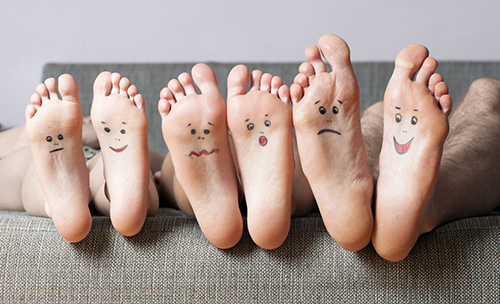
Ingrown Toenail – Ingrown toenails typically occur on the big toe, where the nail is cut short near the tip of the toe. This is then aggravated by placing your ailing toe into a shoe with a too tight toe box which, in turn, causes your toes to be pressed together and creates an abnormal amount of pressure on the nail. The constant pressure results in inflammation and pain. Nonsurgical treatment includes wearing shoes with wider toe boxes and soaking the afflicted toe in warm water several times a day. Cutting the toenail straight across to avoid trimming the corners down too short is advised as well. If conservative treatment fails, removal of part (or all) of the nail may be necessary.
Bunions – A bunion is an enlargement of bone or tissue (often times described as a knobby protrusion) around the joint at the base of the big toe. As the bunion grows the big toe can begin to turn in towards the second toe causing swelling and pain. While it’s true that genetics can play a bit of a role regarding whether or not you develop bunions, wearing too tight shoes is a much more likely culprit. Nonsurgical treatment involves wearing shoes with a wider toe box, taping the toe, or wearing a spacer in-between your big toe and second toe. If nonsurgical treatment is not successful, your doctor may discuss removal of the bunion via surgery.
Corns – A corn is a type of callus that forms when tight shoes put constant pressure on the skin. Corns can even be found between the toes in spots where the toes rub together. Treatment for corns involves applying a foam pad over the affected area to help relieve pressure and, of course, wearing shoes that have plenty of room in the toe area.
Hammer Toes – Hammer toe occurs when a toe curls, as opposed to lying flat in the shoe. The middle joint of the toe bends upwards and, when placed in a tight-fitting shoe, rubs against the shoe surface and causes pain. To add insult to injury, hammer toes often develop a corn on the top of the bend, which increases the discomfort. Simple treatment options include wearing shoes with a wider toe box, strapping techniques, and wearing toe splints; however, surgery may be needed to correct the deformity.
Crossover Toe – Crossover toe forms when toes are crimped in a too tight toe box and the constant pressure causes the second or third toe to move over the toe next to it. The use of spacers and wearing shoes with a wider toe box are, again (are you seeing a theme here?) the simple, conservative ways of treating the affliction. If these methods fail, surgery is – again – an option.
The good news is that there are treatments out there to help heal your feet! Give us a call to schedule an appointment with our foot and ankle specialist, Dr. Krejci!

